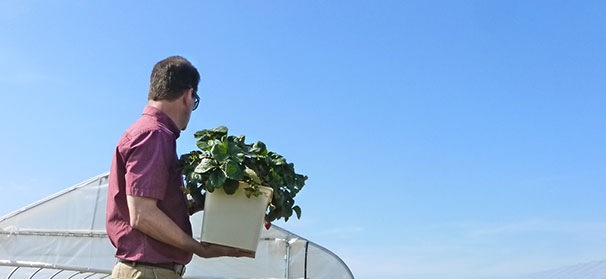

Jul 17, 2014Walmart funds strawberry sustainability projects
Retail giant Walmart has announced a commitment to sustainability, including bringing climate change considerations into its supply chains, requiring suppliers to meet specific standards and reducing energy use in its stores and transportation networks.
“They are really doing things,” said Heidi Welsh, executive director of the Sustainable Investments Institute, “and the key is that they push it into their supply chain. When you have a company as big as Walmart, that is very meaningful.”
Walmart’s sustainability push has had an impact on the strawberry industry. In May, the leaders of 20 projects funded through the National Strawberry Sustainability Initiative (NSSI) gathered in Fayetteville, Arkansas, to share the progress of their work over the past year. The $3.4 million NSSI program was funded by a grant from the Walmart Foundation, which approached the University of Arkansas’ Center for Agricultural and Rural Sustainability about conducting the program.
It’s easy to identify the sustainability issues that might make strawberries a target for attention. Close to 90 percent of the crop is grown in California – an extreme concentration in just one region – and a loss of fumigants, high land prices and lack of water are threatening production in that state. And though popular, strawberries have a reputation as a high-chemical crop.
“The goals of the National Strawberry Sustainability Initiative have been to increase local and regional production of strawberries, improve the environmental and economic sustainability of the production system, and to reduce the environmental impact of production, reduce transportation distances between farms and markets, and reduce product loss during distribution,” said Curt Rom, professor of horticulture at the University of Arkansas and co-director of NSSI.
Many of the NSSI projects studied production systems in parts of the country where there is little strawberry production, but local producers might be able to carve out off-season or local niches. Projects include hydroponic greenhouse production in Arizona and high tunnel production in Arkansas, Nebraska, Texas and Kansas. In some projects, researchers and farmer cooperators were novice strawberry producers, introducing strawberries to areas where row crops are dominant. The next step will be to take a hard look at the economics, because even with high consumer interest in locally grown berries, local producers – whether raising field-grown berries or using off-season protected culture – must compete with inexpensive berries from California, Florida and Mexico in the local supermarket.
Other projects focused on other aspects of sustainability. Projects in California and North Carolina are examining the use of compost and soil health in strawberry production; another California project showed that using four drip tapes instead of two can provide more efficient fumigant distribution and decrease the need for water-demanding overhead irrigation after transplanting.
A New Jersey project is evaluating strawberry breeding selections from a long-term breeding program at Rutgers University, with the goal of expediting release of cultivars well-suited to the Eastern United States. Mid-Atlantic and mid-South plasticulture growers who have found few alternatives to the old workhorse Chandler variety will eagerly await new choices. A Florida project is examining postharvest loss in distribution and has tested a model for tracking product quality loss over time, travel and temperature, showing that a simple rule change to “first-expired, first out” rather than “first in, first out” reduces losses by 30 percent.
The Texas project is creating a sustainable production DVD and companion booklet, “Best Management Production Guide to Texas-Grown Strawberries,” to enhance production within Texas. An Arkansas project has created videos that teach hydroponic production. A Minnesota project has developed an online production manual for cold-climate strawberry production. A North Carolina-based project is making an online diagnostic tool for pest, disease and nutritional deficiencies that will be useful for growers in many regions.
The 20 projects formally wrap up at the end of June, but information on each can be found at strawberry.uark.edu/519.htm, where each project has a report; most also have their own websites, Facebook pages and YouTube channels documenting the work. The Walmart Foundation is supporting a smaller, second-year round of grants focusing on implementation.
Just bringing all the researchers together in one room was a powerful networking opportunity, which might lead to future cooperative efforts on a national or regional scale.
“There was an obvious energy in the room,” Rom said. “This program was unique in the way it has engaged diverse stakeholders. It has clearly made significant impacts that will continue to grow. I feel certain that we will see more, better, higher-quality strawberries which have been sustainably produced enter our markets.”
– Debby Wechsler














